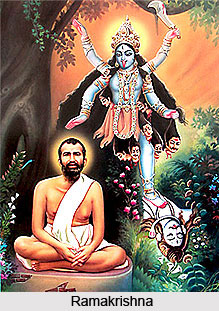 The tradition of Vaishnava Bhakti connotes five "Bhavas" which are Santa( the serenity), Dasya (the attitude of a servant), Sakhya (friendly attitude), Vatsalya (motherly affection) and Madhura(feeling of love of a woman for her lover).
The tradition of Vaishnava Bhakti connotes five "Bhavas" which are Santa( the serenity), Dasya (the attitude of a servant), Sakhya (friendly attitude), Vatsalya (motherly affection) and Madhura(feeling of love of a woman for her lover).
At the time of his belonging in the Dakshineswar Kali temple, after his vision of Maa Kali , Ramakrishna was treasured with the feeling of "Santa Bhava" which is the passive peaceful attitude towards Maa Kali. Ramakrishna practiced some of these "Bhavas". After the marriage of Ramakrishna, he concentrated in practicing "Dasya Bhava" which is considered to be the attitude of a servant towards his master.
Ramakrishna, as a worshipper, started worshipping Rama as Hanuman used to do. Being devoted to Rama, Ramakrishna found himself identical with Hanuman and surprisingly he would walk and eat like a monkey and had been discovered that he spent most of his time in trees. As witnessed by his contemporaries, Ramakrishna had developed a small growth in the lower part of his spine which corresponded to a tail. Ramakrishna happened to had a sight of Sita, the better half Rama, and undergone a feeling of the emergence of her spirit into his body.
After his success over "Dasya Bhava", Ramakrishna moved on to hone "Vasalya Bhava" which is the affectionate feeling of a mother towards her child. Ramakrishna was worshipping an idol of child Rama(Ramlala) at the time when he was executing "Vatsalya Bhava". During his practice of "Vatsalya Bhava" Ramakrishna experienced a tender motherly feeling and had also been witnessed that he developed a feminine attitude and considered himself as a mother. It was stated later by Ramakrishna that he was actually undergoing a feeling of motherly affection and the presence of Rama as a living God in the metal idol was perceived by him.
Ramakrishna after experiencing the two perceptions of Bhavas , ushered in the practice of "Madhura Bhava" which is the love of a woman towards her lover, resembles the kind of love the Gopis showed towards the eternal lover, Krishna. To experience the indepth love of "Madhura Bhava", Ramakrishna, as depicted in his biography, dressed himself in female attire and took him for one of the Gopis of Vrindavan, the birth town of Krishna."




















